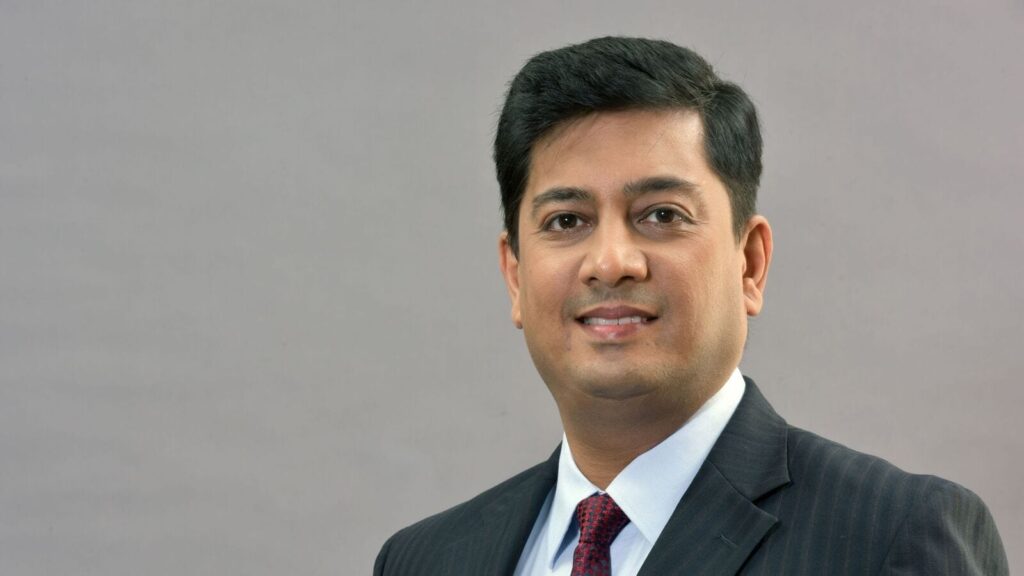The tariffs have raised uncertainty, which the market doesn’t like, said Harsha Upadhyaya, president & chief investment officer at the fund house. “One way of insulating investor portfolios amid this rising uncertainty is by investing in domestic-facing businesses.”
His fund’s portfolios are 85% tilted toward such companies, and prefers large banks, while being slightly underweight on IT.
Edited excerpts:
Reciprocal tariffs have upended markets. Your take?
That global growth will slow down and inflation moving up appear to be a reality now. When you look at the impact, obviously anybody who is exporting to the US will have an impact.
The relative impact on India could be lower compared to some of the other countries, which are competing with us for increasing export share.
Read more: D-Street stumbles as fresh tariff fear feeds into slowdown woes
However, the point is when costs go up for a consumer or business, then there is going to be either deferment of demand or destruction of that demand and that’s what we need to worry about.
If you look at the listed space, it is dominated by domestic businesses in India. So, to a large extent, the impact will be lot lesser compared to what you would otherwise see if all the exporters were listed. Within the listed space also, there are a couple of large US -oriented exporters.
Say IT services are not impacted as of now, but second-order effects can queer the pitch. However, growth may slow down for export-oriented tech companies if companies in the US started feeling the pinch of tariffs. However, from a pure tariff barrier perspective, there is nothing that’s happening to the IT services. With other exporters, too, relative advantage will come into play.
As of now, the listed space may not have a very large impact directly, but the indirect impact or second-level impact is difficult to understand.
Let’s say we supply to another manufacturer in Europe. We may feel that between Europe and India nothing has changed, so everything will be all right. But in turn, if that European manufacturer is supplying to the US, his demand may change or his costing may change. And so that could have a second-order impact on all the suppliers who are involved in that value chain or if, let’s say, one of the countries which was exporting to US earlier starts to look at other export markets. It will be tough to ascertain how these scenarios unravel.
These second-order impacts are something that is difficult to estimate at this point of time, but it’s fair to say that this is one of the large dislocations that we have seen in the global economy, that was built on comparative advantage and globalization over the last several decades; and clearly we are seeing a reversal of that.
The market hates uncertainty and to the extent that they are unable to assess the impact, we will continue to oscillate in terms of prices and valuations over the next few weeks.
There is retaliation by China and the EU, which could complicate issues for financial markets as seen over the past two days, prolonging the uncertainty which markets don’t like.
First of all, we don’t know whether we have had the last word from the US. Secondly, we still do not know what will be the reaction of other countries. We have just seen the reaction from China, but who knows. There could be other reactions from elsewhere or even from China or from the US itself. It’s clearly very uncertain at this point of time. I think we’ll have to wait for a few more weeks, few more months probably, to really get to know the extent of impact that you will see.
Markets will remain volatile is what I guess. The market hates uncertainty and to the extent that they are unable to assess the impact, we will continue to oscillate in terms of prices and valuations over the next few weeks. Volatility will continue.
Isn’t it a challenge to allocate the funds amid such volatility? After all, mutual funds are, in some sense, giving exits to FPIs.
It’s not about giving anybody exits. What we are doing is the same as what we were doing many years back–when there is a flow into our funds whether we like valuations or not, whether we like the economy at that point of time or not, the mandate is to invest into the required asset classes because the investor has already taken that call to invest in equity, fixed income, commodities or whichever that class of asset is.
So, we may decide in the current conditions, which is the better asset class, where there is a little better risk-reward equation, etc. But just because, somebody is selling, first of all, I don’t know whether I should not be buying. Secondly, whether I should be sitting on cash because the investor has already made the decision of investing into equities.
Similarly, at their end, too, investors are deciding. We are all vehicles, mutual funds or some of these FPIs, which are funds abroad. There are different kinds of investors even within the foreign category, just like in domestic. They are also institutional investors driven by different mandates.
Read more: Here are the sectoral winners and losers from Trump’s reciprocal tariffs
If an Investor redeems in their fund, they have to go and execute even if the valuations are low and they believe that a lot of money is going to be made.
But they don’t have the choice to remain in that asset class or that geography. They have to sell that. We can only make relative calls.
You said there is uncertainty and there are many people who are managing other people’s wealth. Are you fully invested now or sitting on a little cash?
We are around more or less at average levels. I would say most of our funds have anywhere between 2% and 4% in cash.
As an investment philosophy at Kotak Mutual Fund, we never take large cash calls. We don’t use cash as a tool to manage volatility or performance because it’s a double-edged sword. Only in hindsight we will know whether that decision is right or wrong and who am I to decide asset allocation for lakhs of investors out there.
Today, when you come to Kotak Mutual fund, for example, you may have completely decided that whatever allocation you wanted to make in equity is happening through that particular fund. Whereas suppose if an investor is coming into our fund and if he thinks that it has to be 50%, it is his decision that he keeps 50% aside and gives only the rest for investing.
Because of the mandate, we keep a cash as we don’t have to necessarily invest everything that comes previous night, the very next morning. But we will not use cash as a tool and we have communicated this to investors clearly. Because the moment I am taking a cash call, you as an investor will never know what am I going to do with it.
In the context of global uncertainty, which sectors are you betting on as a fund house?
Most domestic businesses should be okay because this (global trade uncertainty) is unlikely to impact domestic economic parameters. To that extent, domestic-focused businesses will continue performing as they have been doing.
Our portfolio is anyways tilted towards the domestic basket. I would say depending on which portfolio (small-, mid- or large-caps) you look at, maybe 85% or more will be in domestic facing businesses. To that extent, we believe that our portfolios have already taken the required steps to insulate whatever little drag might ensue from some of the export-oriented or global facing businesses.
As far as our portfolios are concerned from a valuation perspective, we believe that large caps are more reasonable than small caps.
What challenges could outward-facing manufacturing sectors in the listed space face?
Apart from a few listed automakers and jewellery companies, I don’t see many with direct exposure to the US. It’s only auto component manufacturers who may have a direct or an indirect impact of the trade tariffs. But each time you build a portfolio, there are some risks in the portfolio. The question is whether you have taken cognizance of those risks and have you built some sort of mitigation around that or not.
Read more: Amid a tariff war, stay cautious and don’t be swayed by a 10% correction: Siddhartha Bhaiya
As far as our portfolios are concerned from a valuation perspective, we believe that large caps are more reasonable than small caps. The tilt is towards large caps and also from a sectoral perspective it’s very clear that domestic businesses will be a lot more resilient than global export-oriented businesses. That’s where our bulk of our positioning is.
The bulk of your portfolio mix is in domestic businesses, but if you narrow it down to ranking, what would be one of the top ones?
One of the largest exposures we have is large banks, both PSU as well as private, and not just because of what has happened on the tariff side. Even otherwise for the last six to eight months, we’ve been talking about the valuation comfort being in large caps within banks.
There are also the food delivery giants and other services companies that have made it to the benchmark index recently, boosting valuations despite their earnings lagging those excluded from the index. How do you view the index rebalancing you see on the Nifty?
That has already happened. Some of the new entrants do not have same level of profitability and valuations obviously are on the higher side. To that extent, Nifty valuations before and after the rebalance have seen some elevation. But that is captured in current prices.
RBI will make a policy announcement this month. Given the tariffs’ inflationary impact, do you foresee RBI being more proactive or will it have to push harder on the pedal?
Maybe, if you had asked me a few quarters back, I would have said it’s a shallow rate cycle with maybe a couple of rate cuts. But now I think inflation has moderated quite meaningfully. Benign domestic inflation and a possible tariff-induced growth slowdown may give a little extra ammunition to RBI. Maybe, three cuts or more.
Coming back to the markets again, if you have hundred rupees, how would you allocate between multiple asset classes – equity, fixed income, gold or silver?
While there is a crisis around us, every crisis, while being a risk event, is also an opportunity in some sense for investors. Because at least you are not going to be paying a very high valuation whenever the markets are correcting or going down. I would still be overweight on or neutral on equity.
Each individual will have a different level, but I would say a dominant position within asset classes should still be in equities. But within that I would be tilting more towards large caps. So 70% equity, 20% fixed income and 10% silver is what can be recommended over gold.
What to avoid now? IT companies, even though there is a tariff on goods and not on services?
It’s not an avoid on IT. But I may not go overweight IT at this point of time until a little more certainty prevails. We are slightly underweight to equal weight currently. And we will continue with that.
If I have to ask a bit on the fund side–generally the balanced advantage fund or multi-asset allocation fund, would be two of the dominant sort of funds within the larger scheme of things?
It depends on what an investor wants. If we go by the allocation that we discussed earlier, one can do in different equity funds (large-, mid- and small-caps) and different fixed-income funds. But if they don’t want multiple funds, they can choose between a balanced advantage or probably a multi-asset allocation fund. It’s a choice between multiple funds or one fund to do everything.
Until recently, within the correction, investors preferred small—or mid-cap funds. Only recently have large caps started getting some traction. Do you see this continuing?
It’s a choice whether you want multiple funds or one fund to do everything. I mean the only slight change that we have probably seen over the last one or two months is there is some revival in interest towards large caps or the large-cap-oriented category.
Whether it builds further momentum from here is difficult to say, but at least from a valuation perspective, we see more comfort in last year. As a fund house, we have been advocating for a larger tilt towards a large cap, but it’s finally investors’ choice where they want to invest.















